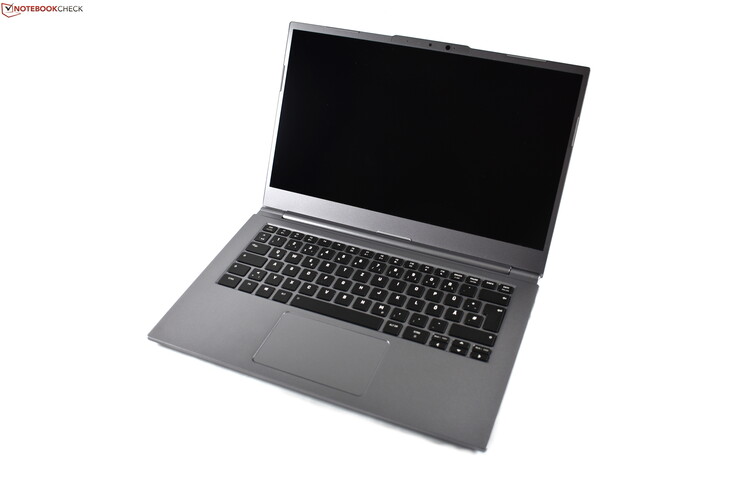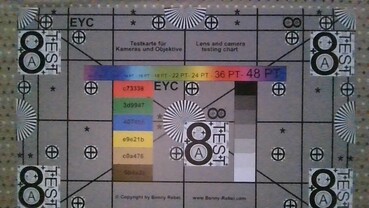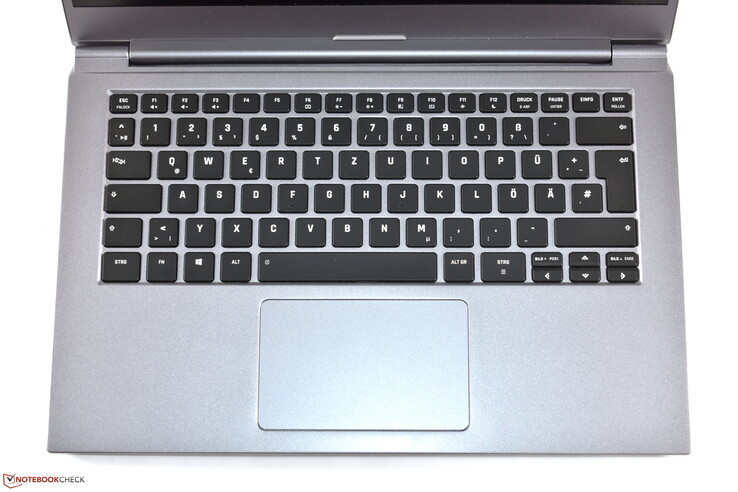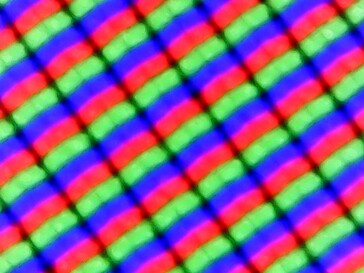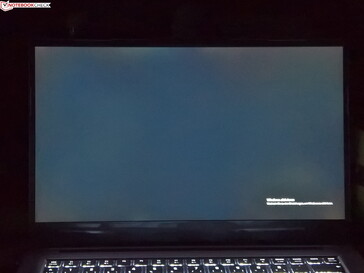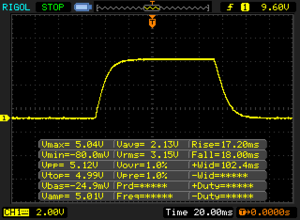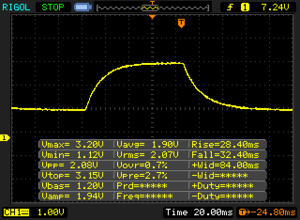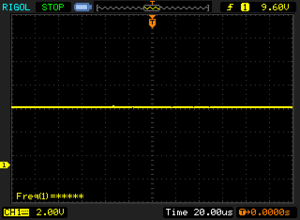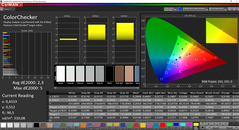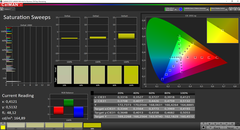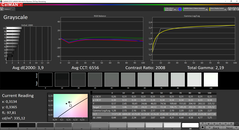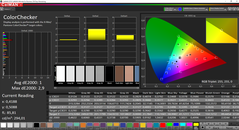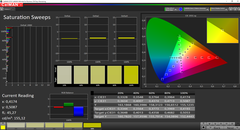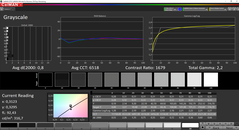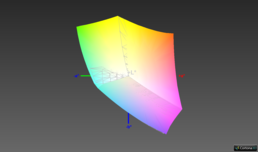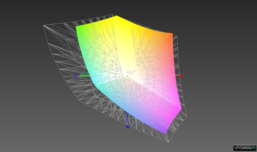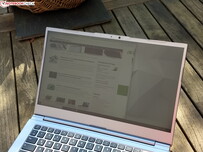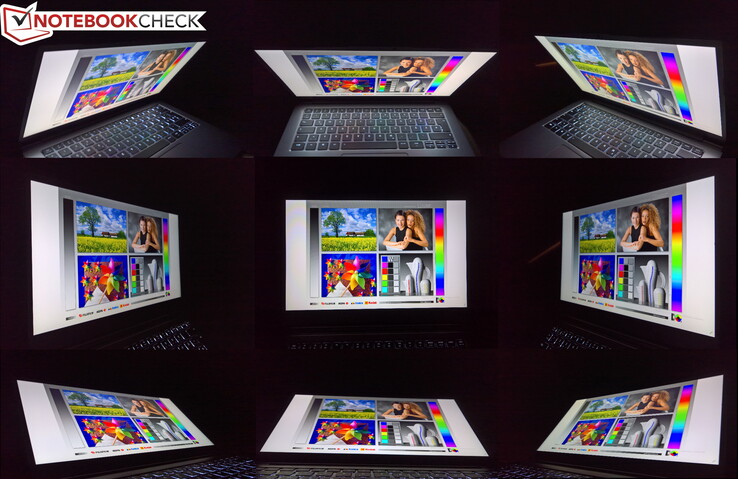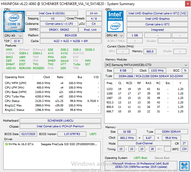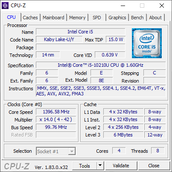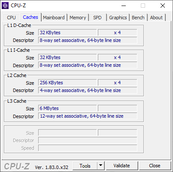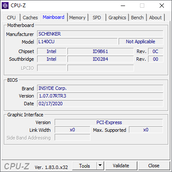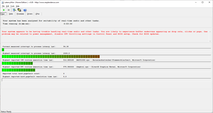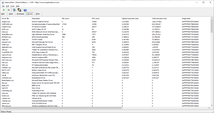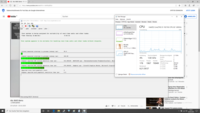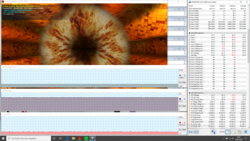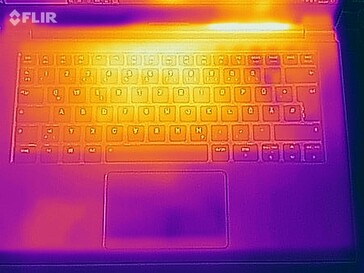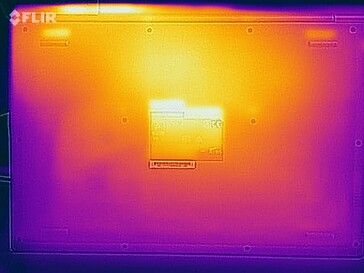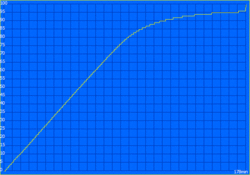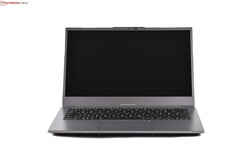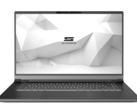Schenker VIA 14 laptop review: Lightweight materials combined with a big battery

The German PC manufacturer Schenker has made a name for itself mainly with its XMG gaming laptops. But the manufacturer wants to compete in different parts of the laptop market, too. The Schenker VIA laptops for example are supposed to attack the office market.
Today's review device, the Schenker VIA 14, has a 14-inch screen, which is still the most popular size in the business market. In this area, Schenker competes with giants like HP (Elitebook 840 G5), Dell (Latitude 7400) and Lenovo (ThinkPad T490s).
Compared with those business systems, the Schenker VIA 14, which we are reviewing in a configuration with i5, 16 GB RAM, 1 TB SSD and FHD screen, is significantly cheaper. The Schenker VIA 14 starts at €1,099 (~$1197) here in Germany. The competitors cost much more with the same amount of RAM and SSD storage. As the Tuxedo InfinityBook S 14 v5, the laptop is available with Linux, too.
Rating | Date | Model | Weight | Height | Size | Resolution | Price |
|---|---|---|---|---|---|---|---|
| 85.6 % v7 (old) | 04 / 2020 | Schenker VIA 14 i5-10210U, UHD Graphics 620 | 1.1 kg | 16.5 mm | 14.00" | 1920x1080 | |
| 88.6 % v6 (old) | 04 / 2018 | HP EliteBook 840 G5-3JX66EA i5-8250U, UHD Graphics 620 | 1.5 kg | 17.9 mm | 14.00" | 1920x1080 | |
| 87.2 % v7 (old) | 09 / 2019 | Dell Latitude 7400-8N6DH i7-8665U, UHD Graphics 620 | 1.5 kg | 18.9 mm | 14.00" | 1920x1080 | |
| 89.3 % v7 (old) | 05 / 2019 | Lenovo ThinkPad T490s-20NYS02A00 i5-8265U, UHD Graphics 620 | 1.3 kg | 16.1 mm | 14.00" | 1920x1080 |
Chassis & Connectivity: Schenker VIA 14 is a Clevo laptop
The Schenker VIA 14 is manufactured by Clevo. The barebone design is used by other manufacturers as well. Appropriately, we would describe the grey look as slightly generic. The screen bezels are small, except for the area below the screen. Above the screen is a reverse notch that provides room for the webcam – seemingly unnecessary, considering the wasted space beneath the LCD panel.
The magnesium-chassis is well made and robust, except for the easily bendable LCD lid. The hinges are not perfectly adjusted: It is not possible to open the lid with one hand and the display wobbles as well. The lid can be opened to 180 degrees. The most attractive quality of this design is the weight: The competitors are all heavier, except the more expensive ThinkPad X1 Carbon Gen 7.
There is a plentiful port selection with legacy ports like HDMI. A microSD card reader is present, too. For charging, Schenker relies on a proprietary charging port, though USB C charging is possible. Thunderbolt 3 on the other hand is missing, a no-go for such an expensive laptop.
RAM and SSD are upgradable, with two M.2 2280 SSDs and one RAM slot. 8 GB are soldered down. A positive fact: The cover is only held down by eleven Phillips head screws. No plastic clips are used here.
Compared to the competing business systems from last year, the Schenker VIA 14 has the advantage of a Wi-Fi 6 card in form of the Intel AX201. Thanks to it, the transfer rates are much higher. The upcoming business models of the competition will support the standard though.
Ports
| SD Card Reader | |
| average JPG Copy Test (av. of 3 runs) | |
| Dell Latitude 7400-8N6DH (Toshiba Exceria Pro M501 64 GB UHS-II) | |
| Schenker VIA 14 | |
| Lenovo ThinkPad T490s-20NYS02A00 (Toshiba Exceria Pro M501) | |
| Average of class Office (22.4 - 198.5, n=31, last 2 years) | |
| maximum AS SSD Seq Read Test (1GB) | |
| Dell Latitude 7400-8N6DH (Toshiba Exceria Pro M501 64 GB UHS-II) | |
| Lenovo ThinkPad T490s-20NYS02A00 (Toshiba Exceria Pro M501) | |
| Schenker VIA 14 (Toshiba Exceria pro M501 64 GB UHS-II) | |
| Average of class Office (25 - 249, n=27, last 2 years) | |
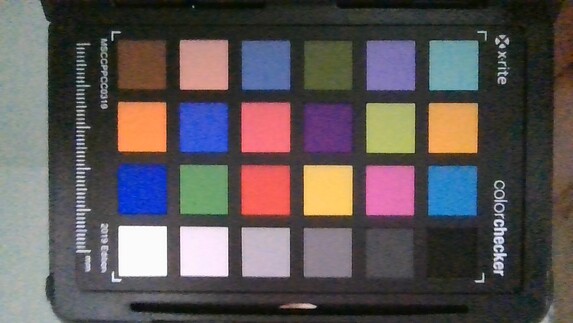
Input devices: Good keyboard in the Schenker laptop
Clevo gave the Schenker laptop VIA 14 a chiclet keyboard with six rows of keys. The keys are backlit with LEDs (two settings), they have a slightly rough surface and a flat, square form. Their typing feel is pretty good; the keys have a snappy pressure point and a good amount of travel. The keyboard does not have any flex to it, another important factor. Even though there are better keyboards (like Lenovo ThinkPads for example), this keyboard can be used to type in longer texts, like the intro of this review. A negative are the extremely small arrow keys.
The touchpad has a smooth plastic surface that allows a smooth gliding of the finger. It is 10.5 cm wide and 6 cm long (~4.1 x 2.4 in), offering an appropriately sized touch-surface. Thanks to Microsoft's "Precision Touchpad" driver, the touchpad works very well. Zoom and two-finger-scroll work without problems. Since this is a clickpad, there are no dedicated keys. The integrated click-mechanism has a crispy click, though it also is relatively loud.
Schenker laptop with Low Power display
The Schenker VIA 14 is on sale with a single LCD option: A matte 14-inch screen with FHD resolution (1,920 x 1,080) without touch. Schenker advertises this panel as "Low Power". In our review device, the panel is made by AUO (B140HAN06.2) and it is based on AHVA-IPS technology. The screen has a good brightness value of 309 cd/m² on average. The competition from HP and Lenovo is better, with roughly 390 cd/m².
The screen has barely any backlight-bleeding and we could not measure Pulse Width Modulation (PWM). A weak point are the response times, especially grey-to-grey. However, the business competitors are not better when it comes to this.
| |||||||||||||||||||||||||
Brightness Distribution: 84 %
Center on Battery: 329 cd/m²
Contrast: 1971:1 (Black: 0.17 cd/m²)
ΔE ColorChecker Calman: 2.3 | ∀{0.5-29.43 Ø4.79}
calibrated: 1
ΔE Greyscale Calman: 3.9 | ∀{0.09-98 Ø5}
99.6% sRGB (Argyll 1.6.3 3D)
65.5% AdobeRGB 1998 (Argyll 1.6.3 3D)
71.6% AdobeRGB 1998 (Argyll 3D)
99.6% sRGB (Argyll 3D)
69.8% Display P3 (Argyll 3D)
Gamma: 2.19
CCT: 6556 K
| Schenker VIA 14 B140HAN06.2, a-Si AHVA-IPS LED, 1920x1080, 14" | HP EliteBook 840 G5-3JX66EA AUO3B3D, IPS, 1920x1080, 14" | Dell Latitude 7400-8N6DH AU Optronics B140HAN, IPS, 1920x1080, 14" | Lenovo ThinkPad T490s-20NYS02A00 B140HAN05.7, IPS, 1920x1080, 14" | |
|---|---|---|---|---|
| Display | -13% | -5% | -3% | |
| Display P3 Coverage (%) | 69.8 | 60.2 -14% | 66.1 -5% | 67.1 -4% |
| sRGB Coverage (%) | 99.6 | 88.2 -11% | 95.3 -4% | 97.6 -2% |
| AdobeRGB 1998 Coverage (%) | 71.6 | 61.3 -14% | 67.5 -6% | 68.5 -4% |
| Response Times | 20% | -5% | -6% | |
| Response Time Grey 50% / Grey 80% * (ms) | 60.8 ? | 42.4 ? 30% | 62 ? -2% | 61.6 ? -1% |
| Response Time Black / White * (ms) | 35.2 ? | 31.6 ? 10% | 37.6 ? -7% | 38.8 ? -10% |
| PWM Frequency (Hz) | ||||
| Screen | -42% | -27% | -6% | |
| Brightness middle (cd/m²) | 335 | 414 24% | 289 -14% | 391 17% |
| Brightness (cd/m²) | 309 | 387 25% | 286 -7% | 389 26% |
| Brightness Distribution (%) | 84 | 87 4% | 91 8% | 87 4% |
| Black Level * (cd/m²) | 0.17 | 0.25 -47% | 0.16 6% | 0.23 -35% |
| Contrast (:1) | 1971 | 1656 -16% | 1806 -8% | 1700 -14% |
| Colorchecker dE 2000 * | 2.3 | 5.5 -139% | 4.7 -104% | 3.4 -48% |
| Colorchecker dE 2000 max. * | 5 | 9.9 -98% | 8.7 -74% | 4.7 6% |
| Colorchecker dE 2000 calibrated * | 1 | 2.3 -130% | 1.3 -30% | 1.1 -10% |
| Greyscale dE 2000 * | 3.9 | 6.4 -64% | 6.4 -64% | 4 -3% |
| Gamma | 2.19 100% | 2.31 95% | 2.54 87% | 2.49 88% |
| CCT | 6556 99% | 7811 83% | 5977 109% | 6809 95% |
| Color Space (Percent of AdobeRGB 1998) (%) | 65.5 | 56.9 -13% | 61.2 -7% | 62.4 -5% |
| Color Space (Percent of sRGB) (%) | 99.6 | 88.1 -12% | 95.1 -5% | 97.4 -2% |
| Total Average (Program / Settings) | -12% /
-29% | -12% /
-20% | -5% /
-5% |
* ... smaller is better
Display Response Times
| ↔ Response Time Black to White | ||
|---|---|---|
| 35.2 ms ... rise ↗ and fall ↘ combined | ↗ 17.2 ms rise | |
| ↘ 18 ms fall | ||
| The screen shows slow response rates in our tests and will be unsatisfactory for gamers. In comparison, all tested devices range from 0.1 (minimum) to 240 (maximum) ms. » 93 % of all devices are better. This means that the measured response time is worse than the average of all tested devices (20.3 ms). | ||
| ↔ Response Time 50% Grey to 80% Grey | ||
| 60.8 ms ... rise ↗ and fall ↘ combined | ↗ 28.4 ms rise | |
| ↘ 32.4 ms fall | ||
| The screen shows slow response rates in our tests and will be unsatisfactory for gamers. In comparison, all tested devices range from 0.165 (minimum) to 636 (maximum) ms. » 96 % of all devices are better. This means that the measured response time is worse than the average of all tested devices (31.7 ms). | ||
Screen Flickering / PWM (Pulse-Width Modulation)
| Screen flickering / PWM not detected | |||
In comparison: 53 % of all tested devices do not use PWM to dim the display. If PWM was detected, an average of 8152 (minimum: 5 - maximum: 343500) Hz was measured. | |||
Ex-factory, the panel does have a slight green tint, which we were able to remove with the CalMan software and the X-Rite i1 Pro Colorimeter. Subjectively, the quality of the of the screen is excellent, thanks to the very good contrast (1917:1), low black-value (0.17 cd/m²) and nearly completely covered sRGB. Basic photo editing is possible with this Schenker laptop.
Outdoors, the Schenker struggles a little bit, despite the matte surface of the screen. A little over 300 cd/m² is not extremely bright. For shadowy places, the brightness suffices.
Performance: Schenker VIA 14 has a PCIe 4.0 SSD
Aside from the Intel Core i5-10210U, the Schenker VIA 14 is also available with the Core i7-10510U. The Intel UHD Graphics 620 serves as the GPU. Concerning the RAM, Schenker combines 8 GB soldered RAM with a single SO-DIMM slot. In our review device, a 8 GB DDR4-2666 module sits in the slot, making it a total of 16 GB (maximum of 40 GB). Schenker uses M.2 SSDs for mass-storage. The Schenker VIA 14 can take in two M.2 2280 SSDs at the same time.
Processor
The Intel Core i5-10210U is an Intel processor based on the Skylake architecture and its newest 14 nm refresh, Comet Lake. The four CPU cores have a clock-rate range of 1.6 to 4.2 GHz. The typical power-consumption is rated at 15 W, which means it is an Ultra Low Voltage (ULV) processor for ultrabooks. Our CPU benchmark-list enables comparisons with other CPUs.
In the Cinebench loop, the CPU can consume up to 35 W for a few seconds, then the consumption slowly decreases to 18 W. The maximum clock-rate for the multicore test is 3.9 GHz, with 18 W it sits at 2.6 GHz. The CPU temperatures are hovering around 95 degrees Celsius (203 degrees Fahrenheit) during the loop test.
Compared with the competition, the Schenker laptop performs well enough. Only the ThinkPad X1 Carbon Gen 7 and the ThinkPad T490 are faster. The ThinkPad T490s and the two AMD models ThinkPad T495s and T495 are on par, while the competitors from Dell and HP are clearly slower.
The CPU performance is limited when no charger is connected. The maximum power consumption in this case is 20 W.
System performance
We do not find any flaws when it comes to everyday performance. In the PCMark benchmarks, the Schenker notebooks performs good as well.
| PCMark 8 Home Score Accelerated v2 | 3587 points | |
| PCMark 8 Work Score Accelerated v2 | 4917 points | |
| PCMark 10 Score | 3810 points | |
Help | ||
Storage
The M.2 2280 SSD in the Schenker laptop VIA 14 was made by Seagate. The FireCuda 520 is a new PCIe 4.0 SSD, which has been put in as a special order for this review. Since the VIA 14 only supports PCIe 3.0, the FireCuda can not quite reach its full potential, though it still is stronger in the benchmarks than the competition, especially while it writes data. The standard SSD in the VIA is the Samsung 970 Evo Plus, which is also good and which we reviewed in the Schenker VIA 15. For consumers, choosing the FireCuda may not make a lot of sense at this point.
| Schenker VIA 14 Seagate FireCuda 520 SSD ZP1000GM30002 | HP EliteBook 840 G5-3JX66EA Toshiba XG5 KXG50ZNV256G | Dell Latitude 7400-8N6DH Samsung SSD PM981 MZVLB512HAJQ | Lenovo ThinkPad T490s-20NYS02A00 Intel SSD Pro 7600p SSDPEKKF512G8L | Schenker VIA 15 Samsung SSD 970 EVO Plus 500GB | Average Seagate FireCuda 520 SSD ZP1000GM30002 | Average of class Office | |
|---|---|---|---|---|---|---|---|
| CrystalDiskMark 5.2 / 6 | -44% | -21% | -28% | -6% | 0% | 20% | |
| Write 4K (MB/s) | 201 | 92.8 -54% | 118.6 -41% | 122 -39% | 164.5 -18% | 201 ? 0% | 155.2 ? -23% |
| Read 4K (MB/s) | 60.2 | 30.67 -49% | 44.68 -26% | 45.56 -24% | 46.88 -22% | 60.2 ? 0% | 72.9 ? 21% |
| Write Seq (MB/s) | 2471 | 353.2 -86% | 1866 -24% | 1497 -39% | 2659 8% | 2471 ? 0% | 2730 ? 10% |
| Read Seq (MB/s) | 2104 | 1937 -8% | 2173 3% | 2385 13% | 2623 25% | 2104 ? 0% | 3265 ? 55% |
| Write 4K Q32T1 (MB/s) | 323.6 | 358 11% | 330.9 2% | 240.9 -26% | 310.9 -4% | 324 ? 0% | 421 ? 30% |
| Read 4K Q32T1 (MB/s) | 551 | 253.1 -54% | 343.1 -38% | 338 -39% | 351.2 -36% | 551 ? 0% | 525 ? -5% |
| Write Seq Q32T1 (MB/s) | 3407 | 359.6 -89% | 1927 -43% | 1528 -55% | 3236 -5% | 3407 ? 0% | 3878 ? 14% |
| Read Seq Q32T1 (MB/s) | 3475 | 2613 -25% | 3528 2% | 2915 -16% | 3547 2% | 3475 ? 0% | 5491 ? 58% |
GPU
The Intel UHD Graphics 620 is an integrated GPU. The performance of the 24 Executive units depends on the RAM, since the GPU has no dedicated memory. To put out the maximum performance, the memory has to run in the Dual Channel mode. This is the case for the Schenker laptop. Since the Intel UHD 620 is pretty slow for today's standard in any case, the difference is not really that huge. For more demanding tasks and newer games, it is too slow.
| 3DMark 11 Performance | 1709 points | |
| 3DMark Cloud Gate Standard Score | 8000 points | |
| 3DMark Fire Strike Score | 1123 points | |
| 3DMark Time Spy Score | 409 points | |
Help | ||
Gaming performance
| low | med. | high | ultra | |
|---|---|---|---|---|
| BioShock Infinite (2013) | 66.3 | 38.4 | 30.8 | 9.3 |
| Dota 2 Reborn (2015) | 63.7 | 36.7 | 18.2 | 16.5 |
| X-Plane 11.11 (2018) | 11.4 | 10.2 | 9.6 |
Emissions & Energy: Schenker VIA is a lot cooler than a Schenker XMG
Noise
Unfortunately, the Schenker VIA 14 does not stay completely quiet while idling. Sometimes the fan does come on with 30.3 dB(A). In the stress-test, the Schenker VIA 14 does get a lot louder with 40.5 dB(A) as the maximum noise-level. On average though, the noise-level sits at 35.6 dB(A) during load.
Noise level
| Idle |
| 29.4 / 29.4 / 30.3 dB(A) |
| Load |
| 35.6 / 40.5 dB(A) |
 | ||
30 dB silent 40 dB(A) audible 50 dB(A) loud |
||
min: | ||
Temperatures
The Schenker laptop barely gets warm during the stress-test. Different from the Cinebench test, the CPU power consumption is quickly limited to 10 W when tested with Prime95 and FurMark. This keeps temperatures low, but also results in strong throttling. In everyday use, this should not be a problem though.
(+) The maximum temperature on the upper side is 35.6 °C / 96 F, compared to the average of 34.3 °C / 94 F, ranging from 21.2 to 62.5 °C for the class Office.
(+) The bottom heats up to a maximum of 34.5 °C / 94 F, compared to the average of 36.8 °C / 98 F
(+) In idle usage, the average temperature for the upper side is 25 °C / 77 F, compared to the device average of 29.5 °C / 85 F.
(+) The palmrests and touchpad are cooler than skin temperature with a maximum of 25.1 °C / 77.2 F and are therefore cool to the touch.
(+) The average temperature of the palmrest area of similar devices was 27.6 °C / 81.7 F (+2.5 °C / 4.5 F).
Speakers
Without bass, not loud enough and not balanced – the speakers of the Schenker VIA 14 are roughly comparable with phone speakers. For listening to music, it is recommendable to use the perfectly working combo-audio-jack.
Schenker VIA 14 audio analysis
(±) | speaker loudness is average but good (73.4 dB)
Bass 100 - 315 Hz
(-) | nearly no bass - on average 22.7% lower than median
(±) | linearity of bass is average (12.5% delta to prev. frequency)
Mids 400 - 2000 Hz
(±) | higher mids - on average 10.3% higher than median
(-) | mids are not linear (18.6% delta to prev. frequency)
Highs 2 - 16 kHz
(+) | balanced highs - only 4.8% away from median
(±) | linearity of highs is average (7.3% delta to prev. frequency)
Overall 100 - 16.000 Hz
(-) | overall sound is not linear (39.1% difference to median)
Compared to same class
» 98% of all tested devices in this class were better, 1% similar, 1% worse
» The best had a delta of 7%, average was 21%, worst was 53%
Compared to all devices tested
» 95% of all tested devices were better, 1% similar, 5% worse
» The best had a delta of 4%, average was 24%, worst was 134%
Lenovo ThinkPad X1 Carbon G7 20R1-000YUS audio analysis
(+) | speakers can play relatively loud (85.1 dB)
Bass 100 - 315 Hz
(±) | reduced bass - on average 7.7% lower than median
(+) | bass is linear (5.6% delta to prev. frequency)
Mids 400 - 2000 Hz
(±) | higher mids - on average 5.6% higher than median
(+) | mids are linear (4.3% delta to prev. frequency)
Highs 2 - 16 kHz
(+) | balanced highs - only 2.5% away from median
(+) | highs are linear (6.9% delta to prev. frequency)
Overall 100 - 16.000 Hz
(+) | overall sound is linear (14.4% difference to median)
Compared to same class
» 10% of all tested devices in this class were better, 4% similar, 86% worse
» The best had a delta of 7%, average was 21%, worst was 53%
Compared to all devices tested
» 17% of all tested devices were better, 4% similar, 79% worse
» The best had a delta of 4%, average was 24%, worst was 134%
Energy management
The power consumption is slightly higher when compared with the competitors. Considering the battery capacity, this is not a huge deal though. The maximum consumption of 69 W is more than the 65 W charger can handle. Luckily, the power consumption quickly decreases to a manageable value of 35.5 W.
| Off / Standby | |
| Idle | |
| Load |
|
Key:
min: | |
Battery life
Pros
Cons
Verdict
Lightweight, fast and enduring: Is there something the Schenker VIA 14 can not do? Indeed, Schenker and Clevo have delivered a fine laptop.
Especially the extremely lightweight chassis in combination with the big battery are compelling arguments for the Schenker laptop. Also, real weaknesses are not many: The matte FHD screen is pretty good, the keyboard is comfortable enough for heavy users. The port-selection is comparably wide, Wi-Fi is fast and the Schenker notebook is upgradable as well. The VIA 14 stays cool at all times, even under load, and it delivers a commendable CPU performance, too.
Just to be clear: The Schenker VIA 14 is not a perfect device. For example, sometimes the fan starts running when the device is idling and can get loud under load. The screen is not as bright as the panels used by the competition and has pretty high response times. Furthermore, the Schenker VIA 14 has DPC latency problems and the speakers are really bad. Also, there is no Thunderbolt and in general less business features (like a smartcard reader or WWAN) compared with the competition. Similarly, there are not as many warranty options as there are with the Dell, HP and Lenovo competitors. For example, an on-site service is not available.
The basics are all on-point – which is why the Schenker VIA 14 gets a recommendation from us.
With those deficiencies in mind, the Schenker laptop might have a hard time competing with the ThinkPads, Latitudes and EliteBooks in the enterprise sector. On the other hand, when it comes to consumers interested in an office laptop, we can see them buying the Schenker VIA 14. It possesses many qualities that we want to see in a good work laptop and is an easy recommendation.
Schenker VIA 14
- 04/06/2020 v7 (old)
Benjamin Herzig




